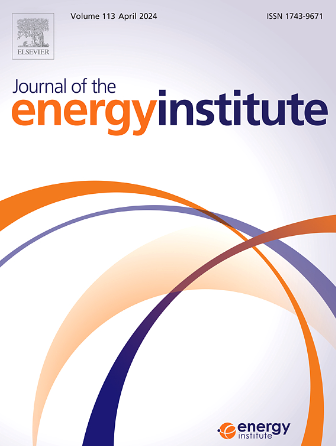煤与生物质共燃结渣特性综合评价模型的建立
IF 5.6
2区 工程技术
Q2 ENERGY & FUELS
引用次数: 0
摘要
煤与生物质共燃过程中的结渣对锅炉的安全性和效率提出了重大挑战。现有研究缺乏一种全面、系统的结渣预测方法,无法准确评估不同煤和生物质组合的结渣风险。为了解决这一空白,本研究通过灰熔融温度(AFT)测试、x射线荧光(XRF)和x射线衍射(XRD)分析来研究无烟煤(AN)和三种作物残留物的成渣行为。此外,采用熵权法和偏最小二乘回归法建立了E-PLS结渣评价模型。煤灰熔融温度(AFT)结果表明,三种生物质的结渣倾向均为中等,而无烟煤的结渣倾向较低。随着生物质的添加,样品的结渣倾向增加。XRD分析证实,生物质的加入促进了石英与钾、钠、钙化合物的反应,增强了钙长石、钾长石、钠长石的衍射强度。E-PLS评价结果表明,三种生物质的结渣倾向适中,无烟煤的结渣倾向较低,与实验结果一致,证明了该方法的准确性。研究结果为预测生物质与煤共燃过程的结渣趋势提供了有益的参考。本文章由计算机程序翻译,如有差异,请以英文原文为准。
Development of a comprehensive model for evaluating slagging characteristics in the Co-combustion of coal and biomass
Slagging during the co-combustion of coal and biomass poses significant challenges to boiler safety and efficiency. Existing research lacks a comprehensive and systematic slagging prediction approach to accurately assess the slagging risks associated with different coal and biomass combinations. To address this gap, this study investigates the slagging behavior of anthracite (AN) and three types of crop residues through ash fusion temperature (AFT) tests, X-ray fluorescence (XRF), and X-ray diffraction (XRD) analysis. In addition, an E-PLS slagging evaluation model was established using the entropy weight (EW) method and partial least squares regression (PLSR). The ash fusion temperature (AFT) results show that the slagging tendency of the three biomass is moderate, while anthracite has a low slagging tendency. With the addition of biomass, the slagging tendency of the samples increases. XRD analysis confirms that the addition of biomass promotes the reaction between quartz and potassium, sodium, and calcium compounds, enhancing the diffraction intensity of calcium feldspar, potassium feldspar, and sodium feldspar. The E-PLS evaluation results indicate that the slagging tendency of the three biomass is moderate, and anthracite has a low slagging tendency, which is consistent with the experimental results, demonstrating the accuracy of this method. The findings provide a useful reference for predicting slagging tendencies during the co-combustion of biomass and coal.
求助全文
通过发布文献求助,成功后即可免费获取论文全文。
去求助
来源期刊

Journal of The Energy Institute
工程技术-能源与燃料
CiteScore
10.60
自引率
5.30%
发文量
166
审稿时长
16 days
期刊介绍:
The Journal of the Energy Institute provides peer reviewed coverage of original high quality research on energy, engineering and technology.The coverage is broad and the main areas of interest include:
Combustion engineering and associated technologies; process heating; power generation; engines and propulsion; emissions and environmental pollution control; clean coal technologies; carbon abatement technologies
Emissions and environmental pollution control; safety and hazards;
Clean coal technologies; carbon abatement technologies, including carbon capture and storage, CCS;
Petroleum engineering and fuel quality, including storage and transport
Alternative energy sources; biomass utilisation and biomass conversion technologies; energy from waste, incineration and recycling
Energy conversion, energy recovery and energy efficiency; space heating, fuel cells, heat pumps and cooling systems
Energy storage
The journal''s coverage reflects changes in energy technology that result from the transition to more efficient energy production and end use together with reduced carbon emission.
 求助内容:
求助内容: 应助结果提醒方式:
应助结果提醒方式:


